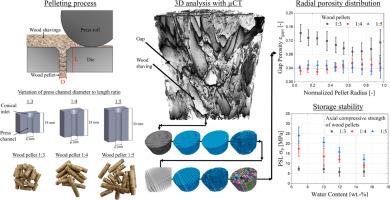压制槽长径比对生物质颗粒储存期间机械性能的影响
IF 7.2
2区 工程技术
Q1 CHEMISTRY, APPLIED
引用次数: 0
摘要
本研究调查了压制槽长度对木质颗粒质量的影响,重点是密度、径向孔隙率分布和机械稳定性等关键方面,包括交货时和储存期间。使用直径/长度(D/L)比分别为 1:3、1:4 和 1:5 的压制槽生产木质颗粒,以评估模具几何形状的变化对颗粒质量的影响。微计算机断层扫描(μCT)分析表明,压制通道的直径/长度比对颗粒内的孔隙率有很大影响。较短的压制通道会导致木质颗粒径向孔隙率分布变化很大,而较长的压制通道则会导致半径范围内孔隙率均匀偏低。此外,用较长的压制通道生产的木粒表面更光滑,裂纹更少,在不同湿度条件下抗结构退化的能力更强。虽然高密度木粒在潮湿环境中显示出更高的机械强度和恢复潜力,但裂缝形式的残留损伤和径向孔隙率分布的改变导致其强度低于初始状态。本文章由计算机程序翻译,如有差异,请以英文原文为准。

Impact of press channel diameter-to-length ratio on the mechanical properties of biomass pellets during storage
This study investigates the effects of press channel length on the quality of wood pellets, focusing on key aspects such as density, radial porosity distribution, and mechanical stability, both at the time of delivery and during storage. Wood pellets were produced using press channels with diameter-to-length (D/L) ratios of 1:3, 1:4, and 1:5 to evaluate how variations in die geometry influence pellet quality. Micro-computed tomography (μCT) analysis indicates that the D/L ratio of the press channel significantly impacts the porosity within the pellets. Short press channels are associated with great variability in the radial porosity distribution of the wood pellets, while longer press channels lead to uniformly low porosity over the radius. Furthermore, pellets produced with longer press channels exhibit a smoother surface with fewer cracks and greater resistance to structural degradation under varying humidity conditions. Although high-density pellets show improved mechanical strength and recovery potential in humid environments, remaining damage in the form of cracks and alterations in radial porosity distribution lead to reduced strength compared to their initial state.
求助全文
通过发布文献求助,成功后即可免费获取论文全文。
去求助
来源期刊

Fuel Processing Technology
工程技术-工程:化工
CiteScore
13.20
自引率
9.30%
发文量
398
审稿时长
26 days
期刊介绍:
Fuel Processing Technology (FPT) deals with the scientific and technological aspects of converting fossil and renewable resources to clean fuels, value-added chemicals, fuel-related advanced carbon materials and by-products. In addition to the traditional non-nuclear fossil fuels, biomass and wastes, papers on the integration of renewables such as solar and wind energy and energy storage into the fuel processing processes, as well as papers on the production and conversion of non-carbon-containing fuels such as hydrogen and ammonia, are also welcome. While chemical conversion is emphasized, papers on advanced physical conversion processes are also considered for publication in FPT. Papers on the fundamental aspects of fuel structure and properties will also be considered.
 求助内容:
求助内容: 应助结果提醒方式:
应助结果提醒方式:


